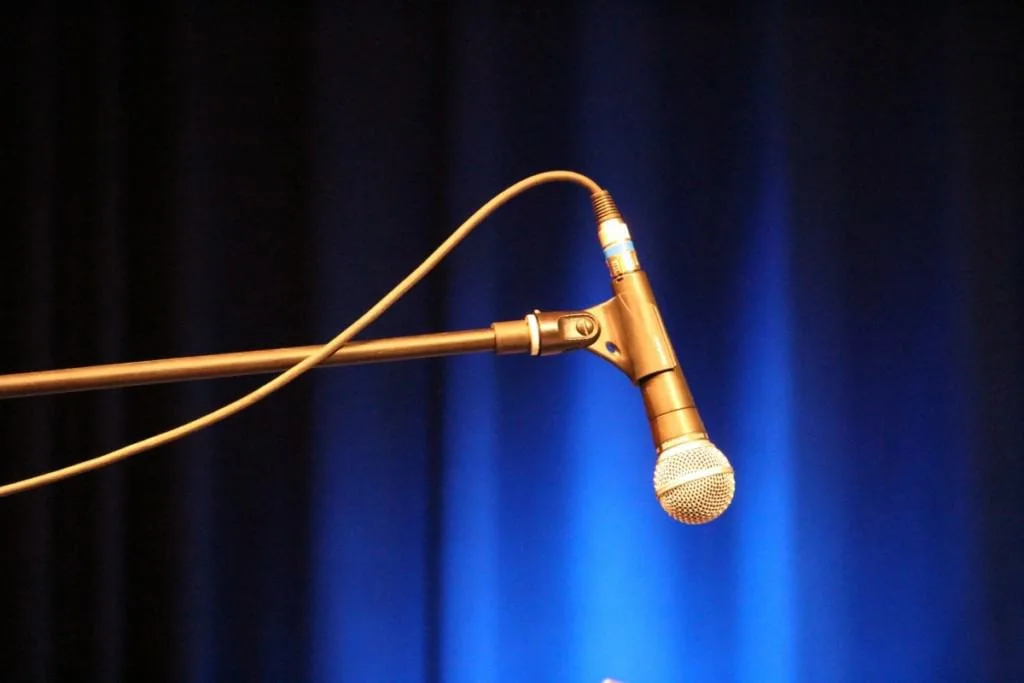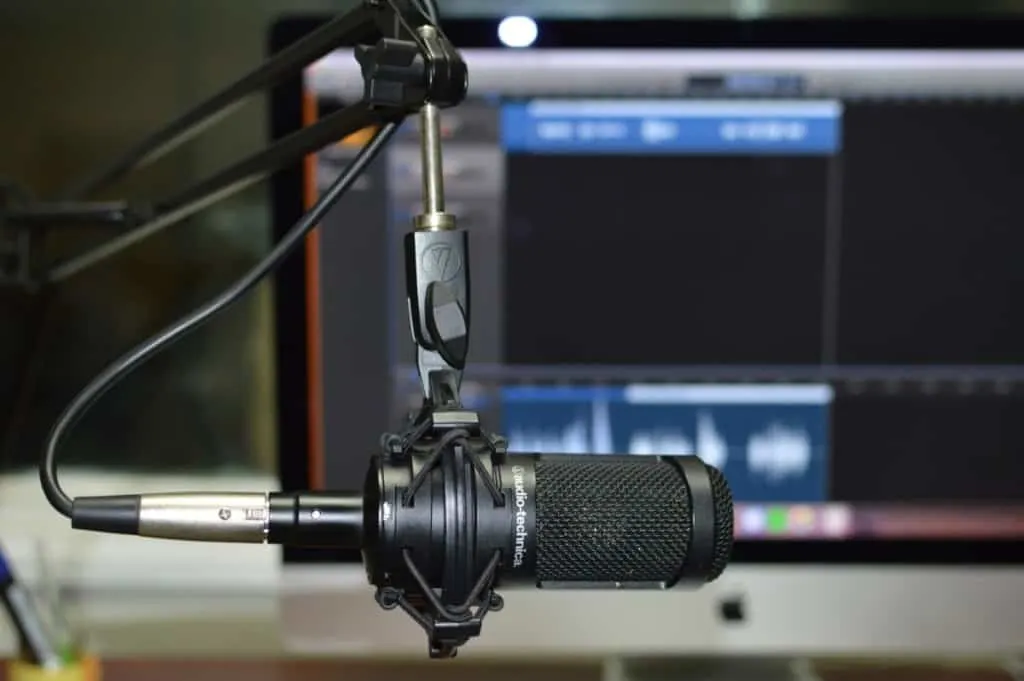Microphone stands are one of the most underrated tools used in a recording studio or live setting. Whether they are universal and compatible with any microphone is an important subject for musicians and sound engineers.
Are microphone stands universal?
Microphone stands all have a universal thread that can be attached to the microphone clip that the manufacturer provides. There are two standard thread sizes for microphones – 3/8″ and 5/8″, which are catered for by almost all mic stands.
However, there is more consideration required to definitively answer this question. Although in terms of attachment most mic stands are universal, that is to say, they can be successfully connected to mic clips and shock mounts, some microphones require heavy duty stands due to their bulky construction.
If you don’t know what a microphone shock mount is check out this article.

Can Mic Stands Be Used Universally with all Microphones?
Mic stands are indeed compatible with all microphones. However, this doesn’t mean that it is as simple as just un-boxing a new microphone and attaching it straight onto any mic stand.
In terms of attachment requirements and sizes, microphones fall into two categories. Firstly some have an attachment which is 3/8” in size, and others have attachments 5/8” in size.
These universal attachments are secured by screwing the mic clip onto the thread of the microphone stand. Most good-quality microphones come with the specific attachments that are best suited to their weight, size, and purpose.
So technically speaking, in terms of attachment compatibility, mic stands are certainly universal. When we look at other aspects of mic stands, it becomes clear that there is more to consider. For example, heavy microphone stands are likely to require stands that balance weight more efficiently so that they don’t collapse or fall over during a recording session or performance.
Below is a table which presents the main types of mic stands, and what they are commonly used for:
| Mic Stand Type | Common Purpose |
| Standard mic stands | Live vocals, amplifiers, speeches |
| Boom mic stand | Drum overheads, choirs, orchestras |
| Short mic stands | Kick drums, bass amps |
| Desktop mic stands | Podcasting, interviews, voiceovers |
As you can see, mic stands may be universal in terms of their attachments, but there are types that are specifically designed for certain recording processes and instruments.
In the following section, we will take a detailed look at the different types of mic stands and what they are best suited for.
Standard Mic Stands
Standard microphone stands are the most common type. Frequently found in recording studios and onstage, these microphones have an upright design. They are ideally suited for vocals and many other applications.
All standard mic stands are not universally effective. Cheaper options are likely to be less stable and are prone to toppling over – potentially ruining a recording or live performance in the process.
Most vocal microphones used for live performance are fairly lightweight dynamic mics. The Shure SM58 is considered to be the industry standard for live vocals, and this attaches with a 3/8″ thread. Standard mic stands are ideal for this type of microphone because they are strong enough to support its weight but also provide the height required to suit all vocalists.
Some of the best aspects of standard mic stands are:
- Lightweight
- Mobile
- Adjustable height
- Adjustable clutches
The height range is integral to making mic stands universal. The large majority of stands allow the user to alter their height, but the actual range is different depending on the manufacturer, model, and desired purpose.
Generally, you’ll find that standard mic stands universally range between 35” and 70” in height. This height range facilitates the most common uses for standard mic stands, such as vocals, micing up a guitar amp, or positioning the microphone in front of an acoustic guitar.
I really like the Hercules range of stands they are well built and function really well.
Check out my go-to Hercules universal microphone stand here on Amazon.

Microphone Stand Clutches
Another important mechanism that makes mic stands universal is clutches. These devices are usually positioned around ¾ of the way up the stand, and allow you to lock the height of the stand firmly in place.
There are three universal varieties of mic stand clutches. These are:
- Twist Secure
- Grip Secure
- Tension Screw Secure
The more popular of these three is twist secure clutches. When you have set the mic stand to the desired height, you simply twist the clutch until it is tight enough to firmly hold the weight of the microphone in place.
Grip clutches are more common on cheaper mic stands. These work by pushing a grip so that it holds the stand in place. They are generally considered to be less secure than twist clutches but provide a good alternative for those who are shopping on a budget.
The other advantage of grip clutches is that they are very fast to secure. This makes them a useful option for live performances when time may be limited and a sound engineer need to quickly set up the mic stands for multiple bands or artists.
Finally, the third universal mic stand clutch is known as a tension screw. These clutches are usually found on boom stands, which we will cover in detail later in this article. Tension screws cause the clutch to press into the stand’s inner tubing to prevent it from moving.
Universal Mic Stand Bases
There are two types of standard mic stand bases that are considered to be universal:
- Flat based
- Tripod based
Flat bases are usually constructed from a durable metal like steel. They need to be heavy enough to support a variety of microphones, from lightweight dynamic vocal mics to bulky condensers. For that reason, mic stand bases perform a vital function.
The shape of flat mic stand bases is usually either circular or triangular. This is because these two shapes provide the most surface area support for the upper part of the mic stand, by spreading the weight evenly.
Compared to tripod-based mic stands, flat-bases take up less room and are therefore more convenient especially if there are multiple stands on a stage or in a recording studio. They’re also not as portable as tripods, but provide extra stability in comparison.
Tripod-based mic stands are available in multiple sizes, all with the standard universal thread sizes. They’re sometimes preferred by sound engineers for their exceptional portability and the fact that they can be folded down and packed away more easily. The only downfall to tripod-based stands is that they are prone to tipping over if the weight is not disturbed evenly amongst the three legs.
Studio Boom Mic Stands
Another form of universal mic stand is the studio boom variety. These stands are specifically designed to be positioned above a sound source so that the microphone can pick up the sound as it rises.
Studio boom mic stands are commonly used for the following purposes:
- Drum Kits
- Orchestras
- Ensembles
- Choirs
Heavy duty and remarkably stable, studio boom stands are great for stretching long distances to record cymbal overheads or room ambiance. They can usually reach over 6ft in length.
There are also some universal features included with studio boom stands which further improve their stability. These include counterweight adjustments to make them more compatible with heavy mics and wheels on the base for improved mobility.
Check out the Hercules boom stand here on Amazon.

Broadcast Boom Mic Stands
For voice-related recordings such as podcasts, interviews, or voiceovers, the best universal option is a broadcast boom mic stand. These stands offer unrivaled flexibility and work by using s scissor-like mechanism that can be adjusted instantly without needing to move the stand’s base.
Broadcast boom mics usually attach to a desk of the surface using a clamp. They also commonly include a shock-absorber to minimize the prevalence of vibration from the desk or surface and keep the recordings as clean as possible. Boom stands vary greatly in quality depending on the particular model.
Here is an example of a high quality, affordable boom mic stand. Check it out here on Amazon.
Universal Mic Stand Accessories
Many accessories exist to improve the overall functionality of a mic stand. These are all fitted or attached to the mic stand using the universal threads or clips and are very useful especially if you are recording multiple sound sources and instruments.
Here is a breakdown of some of the most common mic stand accessories:
- Mobile vocal booths
- Music stand attachments
- Transport Bags
- Gooseneck attachments
- Fast-release adapters
- Stereo bars
Mobile Vocal Booths
Mobile vocal booths are an ideal addition to a home studio or in a situation where inspiration strikes and you need to set up a makeshift studio.
These devices attach to a mic stand and create a layer of soundproofed, absorbent foam that is positioned around the microphone to enclose the sound and improve the clarity of a recording.
Acoustically treating a room is an arduous and expensive process. Thankfully, a mobile vocal booth provides an affordable and efficient solution that is bound to enhance the quality of a vocal take.
Some mic stands come equipped with vocal booths: like this one for example. Check out this mobile vocal booth here on Amazon.
Music Stand Attachments
Universally-fitting music stands are a great tool for classical musicians. They make it possible to read music as the musician is recording or performing. For session players who are expected to sight-read as they play, music stand attachments are invaluable tools.
They are also very useful for vocalists who haven’t memorized their lyrics. Holding a sheet of paper or a notebook in their hand can sometimes distract the singer and make them less focused on their tuning and delivery, so having lyrics sheets mounted on a mic stand is required.
Transport Bags
Moving mic stands from one location to another can be tricky, especially where large stands are concerned. As we’ve discussed, the length of mic stands vary greatly but they all generally adjust back to being at least 35”.
Transport bags universally fit mic stands within them and provide support to prevent any damage from occurring when the stands are packed away and moved around. These bags come in a variety of shapes and sizes, but their purpose is to improve the longevity of the stand and make it easier to store.
Gooseneck Attachments
Another universal accessory that can be attached to a mic stand is goosenecks. These mechanisms allow you to easily adjust the position of a microphone and are commonly used with lightweight dynamics mics.
In a scenario where a microphone needs to be positioned in a small space, goosenecks are very useful. Boom stands or standard mic stands can prove difficult to squeeze into tight spaces, so by attaching a gooseneck you can extend the stand a reposition the microphone without having to move the actual position of the base.
Check out this example of a gooseneck attachment.

Fast-Release Adapters
In some cases, microphones may need to be switched frequently. Fast-release adapters make this process as quick and efficient as possible. The adapters are made up of two-parts and attach to the universal 5/8″ thread located at the end of a mic stand or boom arm.
These accessories allow you to instantly pop the microphone out of the adapter. If you use multiple fast-release adapters, this can speed up the recording process significantly. They make swapping microphones much easier, which can encourage you to experiment with different microphones and can lead to discovering interesting ways of recording.
Stereo Bars
The final type of universal mic stand accessory is called a stereo bar.
Stereo bars essentially make it possible to position multiple microphones whilst still only using a singular mic stand. The more simple variations are used in the XY position, where the mics are placed an equal distance away from each other.
These attachments are great for recording two vocal takes simultaneously, or a pair of string instruments.
Take a look at stereo bars here on Amazon.
| Universal Mic Stand Accessory | Purpose |
| · Mobile vocal booth | · Isolating vocal recordings |
| · Music stand attachment | · Sight reading, lyric reading |
| · Transport bags | · Protecting mic stands during transit |
| · Gooseneck attachment | · Recording in tight spaces |
| · Fast-release adapters | · Quickly swapping mics |
| · Stereo bars | · Using multiple mics on one stand |
Setting Up a Mic Stand for Different Purposes
Although mic stands are universal in terms of compatibility with microphones and attachments, the best way to use them differs greatly depending on the sound source, and the desired results.
For recording vocal takes, a standard mic stand is the preferred option. These stands are adjustable in height and cater to tall, short, or medium-sized singers. Standard vocal mic stands are usually straight, with the option to angle the microphone using a clamp mechanism.
When recording vocals, a shock-mount is commonly used to support the condenser mic. This attachment is screwed onto the thread at the end of the mic stand and provides suspension so that the recording isn’t marred by unintentional motion, which can cause the unwanted sound to be captured.
Standard mic stands are also popularly used for recording guitar. If the guitar is amplified, the mic stand can be angled so that the capsule is positioned right in front of the speaker, to capture the full expression of the electric guitar.
Acoustic guitar, on the other hand, commonly uses the X Y mic placement. This is where a pair of the exact same condenser mics are positioned an equal distance from one another, to prevent phase cancellation from occurring. For this method, a standard mix stand will suffice, but adding a gooseneck adapter may be necessary.
Drums are more complicated when it comes to the mic stands that are required. There are a number of methods used for recording a drum kit, some requiring only three mic stands and others requiring many more. A kick drum requires a shorter mic stand so that the capsule can pick up the transients of the pedal hitting the drum.
Standard mic stands are used for hi-hats and snares, as there is usually adequate room to position them. For overheads and cymbal recordings, boom stands are the best option. This is because they can stretch much further than standard mic stands, and capture the audio from directly above.
The great thing about mic stands is that they are universal, so they fit multiple recording and live-sound purposes.
Related Questions
How many mic stands do you need to record a drum kit?
The popular Glyn Johns method requires only three mic stands to record a full drum kit. It involves positioning two stands equal distance from each other, above the toms. The final mic is placed in front of the bass drum.
What is the best way to secure a mic stand?
If the microphone in question is too heavy for the mic stand, a quick and easy way to secure it is to place fairly heavy objects on the legs so that it can’t topple over. Small sand bags are commonly used for this purpose.
Should you secure a pop filter to your mic stand?
Pop filters usually have a clip attachment that can either be secured onto the pole of the mic stand or the shock mount. It’s important that a pop filter is well-secured, or it may move and hit the microphone during recording.
I have written an article on using 2 pop filters. You can read it here.
I hope you are now armed with all the information you need to make an informed choice on which microphone stand to choose, and why.
Happy recording
